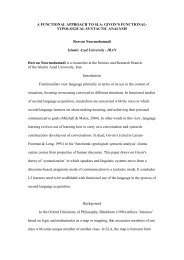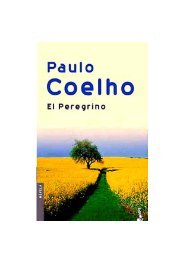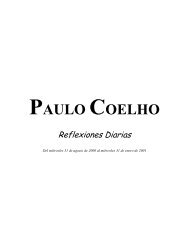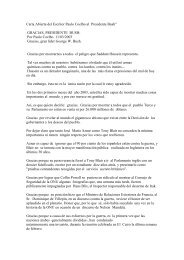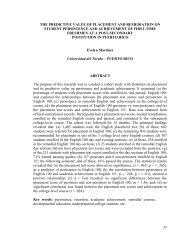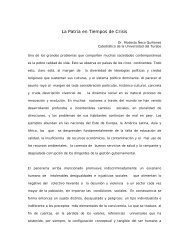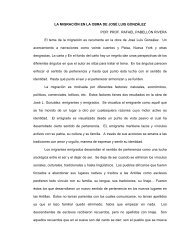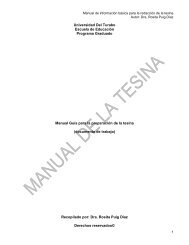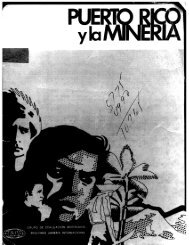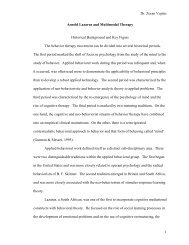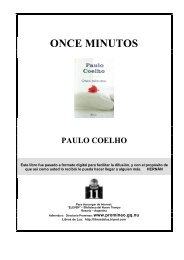Jennet Rodriguez Betancourt
Jennet Rodriguez Betancourt
Jennet Rodriguez Betancourt
Create successful ePaper yourself
Turn your PDF publications into a flip-book with our unique Google optimized e-Paper software.
The Criollo Voice in Alonso’s Jibaro<br />
In an essay read at the symposium, From the New World to Utopia,<br />
“Descolonización Literaria y Utopia: El Caso Puertorriqueno”, Pedro Lopez Adorno<br />
questions how the literary production on the island could become decolonized and<br />
acquire Puerto Rican literary sovereignty if the Caribbean island has never reached<br />
independence at the political or economical level. He points out that because of the<br />
island’s colonial status for over five hundred years, Puerto Rico’s literature has at all<br />
times been produced under the vigilant eye of the colonializer, “De esa manera nuestra<br />
literatura nace (como en toda América Latina) de un encuentro-choque-desengaño entre<br />
conquistadores y vencidos” (López Adorno 1). Since the arrival of Christopher<br />
Columbus (1493), the Europeans confronted an indigenous pre-colonial culture with an<br />
oral cultural discourse which was suppressed, resented, and denied by the colonizer.<br />
From the beginning, the written discourse employed the dominant European voice to tell<br />
the story of the island and of its people from the colonizer’s perspective and personal<br />
interests. “El tapaboca colectivo que Cristóbal Colón inauguró fue el de implantar un<br />
discurso escrito sobre un discurso oral” (López Adorno 1).<br />
The Spanish Crown who feared that the island would develop its own social and<br />
cultural identity was largely responsible for Puerto Rico’s small and slow amount of<br />
literary production. In fact, in the beginning of the 19 th century, the island had an<br />
illiteracy rate of more than eighty percent and 85.4 percent of the civilian population<br />
lived in the countryside (Johnson 13). The first island writers were cautiously consented<br />
by the Spanish Colonial government to chronologically document the island’s history.<br />
1
During the Spanish Colonial rule, writing in Puerto Rico was produced by a literate elite<br />
identified with or representatives of the colonizing power; therefore, the first texts<br />
produced in spite of their detailed descriptions of the land, the customs, and the people<br />
did not integrate the culture. For example, two historical texts that projected a<br />
stereotyped image of the inhabitants of the island in the second half of the 18 th century<br />
were Memoria de Alejandro O’Reilly (1765) and Historia geográfica, civil y natural de<br />
la isla de San Juan Bautista de Puerto Rico de Fray Iñigo Abbad y Lasierra (1778).<br />
Even though these authors wrote about Puerto Rico, Lopez Adorno states that<br />
they did not narrate the traditions that defined the people and the differences between<br />
metropolis and settlement. Both writers presented publicity discourses depicting the<br />
colony “como una colonia rentable, como una aventura sin riesgo” (López Adorno 2).<br />
The docile image sculptured, stressed the similarities that would be desired rather than<br />
the differences that would present a threat for European commerce. In this manner, there<br />
already existed the “Other”-a collective personality in formation which was principally<br />
silenced and hidden from the metropolis for political and business purposes. During this<br />
period, writers under such watchful imperial circumstances were in reverence to the<br />
colonial centre.<br />
Yet, although Puerto Rico has never been independent politically and<br />
economically, writers have continuously been attempting to attain cultural autonomy<br />
through their literature. It is through the written text that writers especially during the<br />
19 th century began developing a discourse-a voice; a voice that evolved from story telling<br />
to its present day position. Spanish imperial conquest had already destroyed the land and<br />
had regarded its inhabitants as disposable; therefore, it was vital that in order for Puerto<br />
2
Rico to develop any type of autonomy, the inhabitants had to be literate because “The<br />
seizing of the means of communication and the liberation of postcolonial writing by the<br />
appropriation of the written word become crucial features of the process of self-assertion<br />
and of the ability to reconstruct the world as an unfolding historical process” (Ashcroft<br />
81). Thus literacy not only produces transformation, but also authority it, “… leads to the<br />
development of historic consciousness. It allows scrutiny of a fixed past. It enables<br />
distinctions to be made between truth and error and so permits the development of a more<br />
conscious, critical, and comparative attitude to the accepted world picture” (Ashcroft 80).<br />
The arrival of the printing press in 1806 dramatically changed Puerto Rico<br />
because more writers began to flourish and institutions like the Royal Academy of Belles<br />
Letters were founded which enormously contributed to the academic and literary<br />
development of the island. In addition, La Gaceta, the first published newspaper began<br />
to circulate. The Spanish government continued to exercise absolute censorship over<br />
newspapers, journals, and creative writing, thus generating a firm literal silencing and<br />
control. However, the literature written by elite Creole or Criollo writers born or residing<br />
in Puerto Rico during the 19 th century slowly began to elaborate the concept of<br />
difference, of “Otherness”.<br />
Writers like young eighteen year old Celedonio Luis Nebót de Padilla who in<br />
1833 published the first literary piece, a drama called Mucén o el triunfo del patriotismo<br />
began signing his work as “joven puertorriqueño” and not “joven español”. Maria<br />
Bibiana Benitez, poet and dramatist, published La Ninfa de Puerto Rico in La Gaceta<br />
(1833). In 1834, Jose Simón Romero Navarro wrote Arrogante Gulleron, Reina de<br />
Nangán, and nine young Puerto Rican writers residing in Barcelona collaborated in<br />
3
writing literary compendiums such as: Aguinaldo Puertorriqueño (1843), Album<br />
Puertorriqueño (1844), Cancionero de Borinquen” (1846), and a second Aguinaldo<br />
Puertorriqueño (1884).<br />
Although this group of young Creole writers evidenced a new form of artistic<br />
expression with a deep love for homeland, they did not communicate “…una firme<br />
expresión de nuestro espíritu, por estar sometidos ingenuamente a los temas y las normas<br />
ya caducas de la literatura española. La imitación supera a la originalidad y el balbuceo<br />
se evidencia” (Pedreira 155). Yet, in their self-expression they began to display a new<br />
self-awareness that was contributing to the beginnings of a new artistic manifestation.<br />
According to Ramón Luis Acevedo, “La literatura puertorriqueña como expresión<br />
colectiva de un pueblo con clara identidad y conciencia de sí mismo comienza hacia<br />
mediados del siglo XIX” (9). He goes on to state that before this period the Puerto Rican<br />
still did not exist as a cultural and historical subject with its own uniqueness.<br />
It is during this period that a new Creole state of mind began to surface and that<br />
writers increased their literary production both in quantity and quality; nonetheless, it<br />
continued under imperial authorization and approval. According to the authors of The<br />
Empire Writes Back, “… early post-colonial texts have the potential for subversion in<br />
their themes, but they cannot be fully developed because of rigid censorship.<br />
Consequently, any type of discourse in the colony is “under direct control of imperial<br />
ruling class who alone license the acceptable form and permit the publication and<br />
distribution of the resulting work” (Ashcroft 6). This is the setting under which Manuel<br />
A. Alonso (1822-1889), one of the most important figures of the group of ascending<br />
young Puerto Rican writers along with Francisco Vasallo son and Santiago Vidarte,<br />
4
produced the first writings El Gibaro (old spelling) in 1849. Antonio S. Pedreira,<br />
affirms, “Cuando aparece en Barcelona la edición príncipe de El Gibaro, 1849, encendió<br />
su luz nuestra primera estrella” (Pedreira 156).<br />
Alonso’s book of verse and prose regarded as “criollisimo” full of costumbrismos<br />
puertorriqueños was cautiously assembled under strong overruling censorship and<br />
authority of Spain’s colonial regime at the time. As Salvador Brau so strongly<br />
emphasizes in the prologue, to understand Alonso’s text the reader must transport himself<br />
to the context in which the author wrote. Brau signals that in Manuel A. Alonso’s case<br />
this was particularly crucial since he was already a target of persecution warned by<br />
Spanish authorities and even by the respected older Puerto Rican writer Francisco<br />
Vasallo “El Buen Viejo,” to not lose sight of “las condiciones del pais para el cual<br />
redactaba sus escritos” (xxxi).<br />
Alonso’s El Salvage, included in Album Puertorriqueño, expressed deep<br />
sentiment while daringly denouncing the white European. Here is an example of one<br />
bold verse in the poem:<br />
Que venga aquí el europeo<br />
codicioso,<br />
Y si acercarse le veo<br />
morirá al punto a mis manos.<br />
Que para sufrir tiranos<br />
En su patria no naci.<br />
After much criticism and suppression, Alonso quickly learned that in order to publish his<br />
works, he had to be watchful of every word and camouflage his ideas and sentiments<br />
5
ehind varied discursive masks. So this time the determined writer focused on the spirit<br />
and way of life of the inoffensive, modest inhabitants of the mountains.<br />
According to Brau, El Gibaro was already categorized as “libro sospechoso”; and<br />
therefore, it would be detained and carefully examined at the port. It was Alonso’s<br />
connection with San Juan’s bishop, Gil Esteve, which redeemed the book of its sins and<br />
helped it enter the island with the church’s blessings of the Catholic Church. Lopez<br />
Adorno states that the literary production of Puerto Rican writers continuously<br />
confronted political, institutional, and ideological obstacles that did not permit it to attain<br />
a larger readership nationally and abroad (Making the decolonized visible 7). Flemming<br />
Brahms affirms that “As a group the Commonwealth nations, however different they may<br />
be, share the experience of colonialism and its subsequent developments. Their histories<br />
vary, but they always need to be understood in terms of a dependence upon the imperial<br />
centre and a later movement towards independence” (66). Brahms further agrees that<br />
these countries exhibit a sense of urgency and an enthusiasm to re-create both their social<br />
and cultural self-hood and many times an obsession with cultural identity is observed.<br />
(66)<br />
The jibaros, one of Alonso’s main themes, were the deprived people from the<br />
countryside or mountains. A jíbaro or gíbaro is an expression meaning hill or forest<br />
people, commonly used to refer to mountain dwelling peasants in Puerto Rico. Francisco<br />
A. Scarano relates in “The Jibaro Masquerade and the Subaltern Politics of Creole<br />
Identity Formation in Puerto Rico, 1745-1823” that the jíbaro initially appeared in<br />
writings during the Spanish colonial period in which elite writers hid their political ideas<br />
behind discursive disguises using the uneducated, inoffensive peasants who lived in the<br />
6
mountains of the island as their shield. He expresses that “The Puerto Rican-as-jíbaro<br />
trope was initially tied to the politics of historically young, ascendant elites; as such, it<br />
formed part of the arsenal that this group used to advance a particular socioeconomic and<br />
political-that is, class-project” (1403). According to this author, in time the masquerades<br />
intention became popularly recognized and the jíbaro symbol assumed a significant role<br />
In his work, Scarano traces the jíbaro masquerade of the early 19 th century<br />
signaling three instances in which Creoles wore jíbaro masks with the obvious intent of<br />
disguising a political message or simply voicing disapproval. In 1814 a letter, from an<br />
anonymous writer signing with the pseudonym of the patient jíbaro denounced an abuse<br />
by local tax authorities in the Diario, a Puerto Rican newspaper. Later in 1820, El<br />
Investigador published an anonymous poem, Coplas del Jíbaro which satirized reactions<br />
of both island and peninsular conservatives against Spain’s liberals. Another instance in<br />
which the jíbaro was used was in 1822, the Diario liberal y de vriedades de Puerto Rico<br />
printed poems by anonymous correspondents who exchanged verses between two peasant<br />
families, in a peasant culture, using peasant expressions.<br />
Although Alonso was not the first to use the jíbaro as trope in the 19 th century, he<br />
was one of the most exceptional authors to express and describe the peasant language and<br />
the rural and urban traditions of the jíbaro. Describing Alonso, Auffant Vázquez says<br />
that his work is “…el más representativo por que une el lenguaje al proceso de<br />
pensamiento de su momento” (xiv), and that it “…expresa la sincera revelación del alma<br />
nuestra, en el tardío y lento amanecer de las letras boricuas, cuyo mediodía aun no se<br />
logra plenamente. La política, la educación y el progreso sostienen el aliento de su<br />
criollísimo festivo y sano humorístico” (Auffant Vázquez 14). Alonso is also considered<br />
7
the first exponent of costumbrismo (cultural mannerist) or Creole literature, in fact “…el<br />
criollísimo salvó al fin su primer libro sagrado” (Martínez Masdeu 158).<br />
In this work, I will explore how Manuel A. Alonso Pacheco in selected vignettes<br />
of El gíbaro (1849), skillfully eluded censorship by using diverse literary devices or<br />
masks in the midst of the extraordinary oppression imposed by the Spanish colonial<br />
government at the time. Three topics that continuously surface in his work are: the<br />
beginnings of a Puerto Rican identity (uncovered in descriptive jíbaro verses), and the<br />
author’s ideas and concerns with progress and education (cautiously inserted in writings<br />
in prose). During the 19 th century, this author of Criollo self-identification, not only<br />
recorded the customs and traditions of the jíbaro; but he significantly contributed to the<br />
beginnings of a Puerto Rican identity by appropriating and uplifting this peasant figure<br />
without crossing imperial boarders. Auffant Vaquez states that “los obstaculos de la<br />
censura los venció con el folklore, el humor, lo onírico fundamentados en el elemento<br />
innegable: el puertorriqueño” (xv). In El gíbaro, Alonso recreated the feelings of a<br />
shared belonging –a Creole identity in its initial stage; according to Lopez Adorno, this<br />
text recorded the commencement of a cultural nature belonging to a collective group.<br />
Manuel A. Alonso was born in San Juan to Spanish parents that classified him as<br />
a Creole or Criollo. In 1842, he moved to Barcelona where he went on to become a<br />
doctor in medicine and surgery. After six years, when he returned to the island in 1848,<br />
he lived in Caguas, but left on two occasions and in 1871, he returned to San Juan where<br />
he worked as director of the Casa de Beneficencia while also directing El Agente, a<br />
reformist newspaper. Alonso wrote El Gibaro while studying in Barcelona, absent from<br />
his country for six years. Like most writers away from their homeland, he was full of<br />
8
nostalgia and a deep urgency to revisit, and record moments and places left behind. In<br />
Advertencia a los lectores, he writes “Al escribirlo me propuse pintar la sociedad tal cual<br />
existía en el año 1842, cuando me trasladé a aquella ciudad teniendo solo diecinueve<br />
años” (Alonso xli).<br />
This young author who published under the pen name of El Gibaro de Caguas<br />
wrote El Gibaro, a collection of vignettes about customs (cuadro de costumbres) in prose<br />
and verse which consist of 20 scenes, writings dedicated to several friends, and other<br />
articles in two parts. An expanded 2 nd edition was published in 1847, where a more<br />
mature Alonso continued to write about earlier themes, with more explicit criticisms, a<br />
short story, Perico Paciencia, as well as a prologue written by Salvador Brau which<br />
scholars today consider a valuable piece of literary criticism. Many of the vignettes<br />
present portraits of Creole every day life, in which Alonso masterfully transcribes and<br />
imitates rural speech patterns. This author not only gathers the customs and traditions of<br />
the island’s modest rural folk, but as Acevedo points out<br />
“… las enjuicia de acuerdo a criterios de progreso, originalidad, y utilidad económica y<br />
social. El interés en los asuntos de Puerto Rico, el patriotismo critico y activo, la<br />
intención didáctica de ensenar deleitando, el humorismo, el optimismo cauteloso y la<br />
simpatía por lo popular son rasgos que se destacan en El Jibaro y que encaminan nuestra<br />
literatura por la autorreflexión y definición de lo propio” (14)<br />
Alonso was an educated Creole who assumed a peasant identity and voiced his<br />
deep sentiments about the people, the island, and the traditions. Throughout the<br />
enjoyable, humorous, and serious accounts the author depicts the activities of the<br />
romanticized rural folk “que trabaja, canta baila, se diverte, se lleva su hambra a caballo o<br />
se casa por la iglesia; que cree en brujos, hechiceros, y curanderos…” (Melendez Muñoz<br />
9
1). According to Meléndez Muñoz, Alonso begins integrating in his stories the typical<br />
characteristics of the Puerto Rican of the time and how the very soul and spirit are<br />
artistically captured in an entirely collective manner. In fact, in verses like Un<br />
casamiento jibaro, El baile del garabato, Una pelea de gallos, and La fiesta de Utuao,<br />
this author describes the customs and traditions of the country folk of the island. By<br />
choosing to relate humorous jíbaro stories and even signing with the pseudonym el<br />
gíbaro de Caguas, this author wisely saved his book from censorship.<br />
In Scene IV, Un Casamiento Jibaro, the clothes worn by the bride and groom are<br />
described in vibrant jíbaro speech which clearly reveals a different manner of speaking,<br />
“… Los hombres ensapataos<br />
Y casi toos con chaqueta,<br />
Yeban aygunos pañuelo<br />
Amarrao en la cabesa<br />
Y sombrero e pelo negro,<br />
Tejio entero, o de empleyta,<br />
Camisas aymionaas,<br />
Y carsones e tapeta.<br />
Las mujeres yebangorras<br />
De pelo con plumas negras,<br />
Guantes de lagoon tejios.<br />
In, La fiesta de Utuao, a story to compae Pepe is narrated about the jbaro’s<br />
experience at the festivities in Utuao, the municipality that “…como es sabido,<br />
representaba el espacio típico de la jibaridad de la montaña…” (Forastieri-Braschi<br />
XXXII). Food, dance, men, women, the usual brawl (which accompanied most parties),<br />
the town mayor, and the priest were all portrayed with lively peasant language and style.<br />
10
These scenes on the surface portray the characteristics of the jíbaro, yet between the lines<br />
they expose disparity from the metropolis and the beginnings of uniqueness. “Al<br />
diferenciar entre el isleño respecto al peninsular define la puertorriqueñdad” (Auffant<br />
Vazquez xii).<br />
Alonso firmly believed that the jibaro’s customs and celebrations were quickly<br />
being forgotten and replaced; therefore, and he felt a true obligation and urgency to return<br />
to, defend, remember, and document the trullas or aguilnaldos, bodas, competencias de<br />
caballo, juegos de gallos, velorios, etc. and the distinctive traditions that accompanied<br />
them. Defenitely, Alonso brings the jíbaros to center stage throughout the many<br />
descriptions of their popular festivities and traditions. “En esta decada XIX, el tema<br />
jíbaro se hizo por vez primera preocupación científica y literaria…, puede decirse que se<br />
cultivó tan ampliamente que ninguna otra época posterior ha podido aventajar la variedad<br />
de su desarrollo” (Pedreira 9).<br />
Córdova Iturregui in an interview by Angel Collazo Schwartz states that “…en<br />
todo momento Alonso observa lo popular con un amor extraordinario” (22). He goes on<br />
to marvel at Alonso’s respect and ability to describe scenes with so much color and<br />
meticulous detail<br />
“…como se entrena un gallo, las plumas de los gallos, las diferentes formas de<br />
los gallos, el tipo de pelea que hacen los gallos. Solamente una persona que<br />
desde su juventud prestase una atención profunda a las actividades propias del<br />
pueblo, como el baile las jugadas de gallo, las carreras de caballo, podía<br />
describir, por ejemplo, ese bando de San Pedro, los detalles que ofrece de esa<br />
fiesta, que es una fiesta carnavalesca… Es algo extraordinario” (22).<br />
11
Córdova Iturregui insists that even today “…algunos grupos folklóricos pueden<br />
montarlos porque siguen la descripción de Alonso” (22). Forastieri-Braschi in his critical<br />
edition of El Gibaro (2007), further states La Gallera (Scene VII) “…todavía hoy es la<br />
descripción mas completa de esa costumbre en Puerto Rico (XXXVIII).<br />
Una Pelea De Gallos, Scene VIII and A Mi Amigo D. Miguel Delgado, Scene XV<br />
are also writings full of descriptions and fine details which demonstrate his enthusiasm<br />
for cock fights. Alonso narrates that any municipality on the island can go without<br />
cultural events, and even a town mayor; however, “…cuando se trata de fundar una nueva<br />
población no es extraño ver que aparece este edificio antes que la iglesia…” (Alonso 55).<br />
These descriptions clearly evidence the writer’s keen awareness of the cultural and<br />
popular traditions and forms of the island; nonetheless, they also expose Alonso’s<br />
concern with the apparent lack of progress that the island is confronting.<br />
In Scene V, Bailes de Puerto Rico, Alonso describes the dances in Puerto Rico<br />
making a clear distinction between los bailes de garabato from los bailes de sociedad.<br />
He clarifies that although el garabato is an inferior dance used by the popular class, it has<br />
“… sus reglas, que se observan con todo rigor, y que nadie que toma parte en ellos esta<br />
dispensado de guardar estrictamente. Aunque, como he dicho, son propios de la gente de<br />
la clase inferior y del campo, algunas veces he visto bailar en ellos a personas muy<br />
distinguidas” (47). He continues to cautiously voice that despite the fact that the island<br />
doesn’t have theatres open all year round or enough people to attend them, “En cuanto a<br />
los bailes nada tenemos que envidiarle al mundo” (48).<br />
Once again through the lens of this young writer, the beginnings of a new Criollo<br />
identity is being recorded; yet between the lines, Alonso continues to articulate his<br />
12
concerns about the needs of more theatres and cultural events so as to advance in the<br />
appreciation of the arts and not chiefly to concentrate on cock fights and dances which<br />
are events which he believes contribute little to the future progress of the island.<br />
Besides Alonso’s respect and affection for the jíbaro’s popular culture, he was<br />
also extremely attentive and caring to the peasant’s needs especially when it was related<br />
to mental health conditions. It is evident that he is a doctor concerned with the health and<br />
above all, the human dignity of the patient. In Scene X, Los Sabios y Los Locos En Mi<br />
Cuarto, he uses the literary technique of dreams and of appropriating characters in this<br />
dream in order to diverge suppression while masterfully voicing his sentiments about the<br />
neglect and abuse in Puerto Rico’s mental institutions.<br />
Alonso uses a 1 st person fictive narrator who has a dream in which four celebrated<br />
French men that worked with mental patients appear in his room. One of these men was<br />
Pinel, a wise, well known, older character, joined by four mental patients from France<br />
who call themselves “la comision de locos”. One patient affirms that some institutions<br />
in France are of high-quality “…buenas camas, buenas comidas, buenos baños, no nos<br />
maltratan los guardias, un profesor sabio dirige el establecimiento y nada se le olvida<br />
cuando se trata de nuestra comodidad y pronta curación…” (Alonso 84). At the same<br />
time, other patients are disturbed because all patients do not enjoy equal and fair care and<br />
many institutions do not even count with a director to oversee and defend the patient’s<br />
innumerable needs. One patient describes his contrasting experience and Pinel is<br />
outraged when he hears about the deplorable conditions and treatment.<br />
“A nosotros no se nos tratan con tanto cumplido como allá en su tierra de usted;<br />
nos tienen encerrados y en completa incomunicación en unas habitaciones<br />
húmedas y hediondas; nuestra cama es una poca de paja; no tenemos salas de<br />
13
estudio, ni patios, ni jardines; comemos como las fieras cada uno en su rincón, y<br />
cuando la miseria y los malos tratamientos acaban de trastornar nuestro juicio<br />
nos encierran en una jaula o nos atan como a perros con un collar y una<br />
cadena.”(Alonso 86)<br />
After much uproar, a Puerto Rican patient respectfully requests that he be<br />
permitted to speak about his country and when he is granted the opportunity, the dream is<br />
interrupted-he (Alonso) is awakened and the reader is left wondering what the Puerto<br />
Rican patient would have said. This was a brilliant way to avoid oppression. First, the<br />
setting is France, not Puerto Rico. The complaints are not from the Criollo because he<br />
was never able to articulate his opinion. Yet, the negative conditions were undoubtedly<br />
exposed and contrasted with the fair and humane ones using fictive characters. Most<br />
importantly, Alonso didn’t assert anything-he didn’t need to; the question to anyone who<br />
knew the island was already answered. Censorship was evaded and between the many<br />
layers, the message was undeniably communicated. The neglect, the injustices, and the<br />
ill-treatment were voiced through the characters of a different race and in another land.<br />
Once again there is a hidden transcript in which what is left unsaid is just as important as<br />
what is.<br />
In Espiritu de provincialism, Scene I, Alonso once more evades censorship using<br />
fictive characters and the literary technique of a story within a story. In this vignette<br />
there is a masked criticism to those who believe that their culture is superior to others.<br />
The author escapes repression by presenting a dialogue between three characters: a<br />
Cuban friend named Pepe, a young arrogant Cuban student (el cubanito), and the<br />
narrator, a Puerto Rican which is perhaps Alonso himself. The cubanito is a student in<br />
14
Barcelona who does everything, but study (a highly condemned topic by Alonso in many<br />
of his narrations).<br />
During the characters first meeting, the wealthy, spoiled student constantly<br />
disapproves of Barcelona (where Alonso deliberately places him) which he insolently<br />
refers to as “…un país en que hay tan poco trato, ese maldito dialecto o jerga que me<br />
horripila, estas costumbres, estas comidas, todo en fin me aburre tanto…” (Alonso 4).<br />
Several days later, the three characters meet again and the Puerto Rican (Alonso) decides<br />
to play a joke on the cubanito, (creating a story within a story), constructing an imaginary<br />
conversation with an Englishman who has become wealthy in Puerto Rico by exploting<br />
the land and its people “…cuatro años negrero, otros cuatro semicontrabandísta, y siete<br />
hacendado: total quince, para llegar después a propietario acomodado, _y no perdona<br />
usted sus faltas a aquel país que las ha pagado en libras esterlinas? (Alonso 6). The<br />
Englishman angrily replies that he will never like that terrible country whose disgusting<br />
food has made him fat and ill.<br />
After listening to the narrator’s words, the upset cubanito wants to know the<br />
response to the arrogant, abusive Englishman. At this point Alonso humorously turns the<br />
focus on the cubanito asking him what he would’ve replied. The student replies exactly<br />
what was expected, “¿Yo?, que era una bestia, un mal educado, que no tenía presente que<br />
hablaba con un puertorriqueño” (7). Nothing more needs to be said, Alonso’s trick has<br />
been successful and the cubanito, not Alonso, not a Puerto Rican, has voiced the lack of<br />
respect, humiliation, and total discontent that a human being feels when an offense of this<br />
manner is directed towards him and or his country.<br />
15
The cubanito has outwardly expressed that he would not tolerate what he himself<br />
had previously done. Once again by using diverse literary devices and expressing truths<br />
halfway this author has uncovered some very serious denouncements towards the<br />
metropolis; in this case insults masqueraded by an Englishman and a cubanito in<br />
Barcelona. Córdova Iturregui states, “Es una escena maravillosa, que resalta por su<br />
carácter democrático y respetuoso hacia todas las culturas” (20).<br />
Like Salvador Brau, Cordova Iturregui agrees that anyone reading El Jíbaro must<br />
be transported to the historical, cultural, and political context in which Alonso wrote.<br />
The reader must also bear in mind that Puerto Rico’s literature bloomed in the hands of<br />
young writers who were continuously under the watchful eye of the colonizer who<br />
permitted very little tolerance or space for self-expression. He further stresses that<br />
Alonso was a reformist who wanted Puerto Rico to move toward modernization and<br />
progress with the help of the metropolis. “Alonso no era revolucionario, sino un<br />
reformista que proponía en todo momento el diálogo como solución a los problemas del<br />
país: hay que entenderlo en esa dimensión” (Cordova 22). Alonso wanted an association<br />
with Spain, but he also wanted all the rights that accompany this alliance. That’s why he<br />
promoted dialogue and not conflict while cautiously struggling for progress and a literary<br />
space that was almost inexistent.<br />
According to Luis Felipe Diaz, Alonso was a liberal and his book reveals the<br />
author’s own social project. “En El gibaro de Manuel Alonso se nos revela, en tal<br />
sentido, como el más formidable intento de textualizar los deseos y aspiraciones de<br />
progreso social de unos grupos liberales comprometidos, ya directa o indirectamente, con<br />
la producción material y simbólica que se desprende de la actividad hacendado-<br />
16
capitalista” (Díaz 41). Within the text, Díaz emphasizes that it is important to rescue “…<br />
la noción de un sujeto- hablante que, sin conciencia plena de su proceder, se dispone a<br />
proyectar (a crear) la visión tanto real como utópica de un nuevo proyecto social” (41).<br />
Alonso was constantly looking to the future towards change and progress and he believed<br />
that it could be accomplished through educating the jibaro. With Spain’s help this pursuit<br />
of progress for the island could be reached. Scenes I, III, IX, XIX, address one of<br />
Alonso’s major concerns and themes, education.<br />
In Reflecciones Sobre Instrucción Pública A Los Padres De Familias, Scene III<br />
Alonso stresses and warns that the best contribution that parents can give their children is<br />
a good education; an education that unfortunately Puerto Rico does not offer.<br />
Throughout the vignette, he reveals the appalling educational conditions and contrasts it<br />
with the superior education offered in the metropolis and even in Cuba. In addition, he<br />
reveals that many “señoritos” sent abroad to acquire a better education just waste their<br />
time and their parent’s hard earned money (an example in Scene I previously discussed).<br />
Alonso inserts recommendations that could contribute to elevate the quality of<br />
instruction, “En cuanto al colegio centro de estas escuelas en mi concepto debería ser un<br />
establecimiento en el cual se enseñara filosofía tal como previene el plan de estudios que<br />
rige en España, adoptando en el los mismos métodos y obras, para que nada nuevo<br />
encontrara un estudiante al llegar a la Península…” (31).<br />
While Alonso concludes the vignette motivating parents to claim a fair and<br />
superior education for their children, it is evident that the author writes with much<br />
caution and reverence towards the Spanish Crown.<br />
“Sin instrucción no puede haber adelanto en las artes y la industria que tanto necesita el<br />
país; los extranjeros nos comprarán siempre nuestros productos para elaborarlos, y hacer<br />
17
después que los paguemos a peso de oro; desvelémonos pues; y cuando todo esté<br />
allanado, reclamemos la protección del Gobierno, que nunca se la niega a un pueblo que<br />
pide medios para instruirse; venzamos todos los obstáculos, y digamos entonces al<br />
Soberano: “Somos religiosos, somos leales, somos honrados, somos hospitalarios; sólo<br />
nos falta que nos permitáis ser sabios” (33).<br />
The vignette exposes enormous deficiencies and neglect, but the author’s opinion<br />
and adamant disgust, inferiority, and shame are carefully masked by addressing the<br />
parents to pay more attention to the needs of their children’s education and to respectfully<br />
ask for the Colony’s assistance. From the start Alonso dedicates this vignette to the<br />
“padres de familía” and not to Spain. In fact, he exalts the Peninsula and puts the burden<br />
on the parents, yet between the lines he has uncovered the injustices and inequalities that<br />
Puerto Rico’s educational system was facing while trusting that the “Soberano<br />
Protector” would permit the people to become wise and enlightened.<br />
In Scene IX, Escritores Puertorriqueños, Alonso revisits the topic of education<br />
and begins “La literatura, ha dicho un escritor célebre de nuestra época, es el termómetro<br />
verdadero del estado de la civilización de un pueblo…” and continues “…la literatura<br />
marcha sin avanzar más de lo que permiten las circunstancias del país…” (69). Alonso<br />
continues to stress the magnitude of decent educational opportunities,<br />
“Cuando una juventud ávida de instrucción la adquiera en las escuelas del país a que<br />
ahora puede alcanzar un reducido número de privilegiados; cuando esta juventud se<br />
dedique a profesiones que en el día se miren con desprecio, porque son casi ignoradas,<br />
entonces estará el grano de sazón y brotara dando después abundantísima cosecha.<br />
Sembrar en un campo cubierto de malezas es perder el tiempo y la semilla” (70).<br />
After Alonso discloses the existent educational truths, he inserts a significant<br />
literary analysis of a remarkable poet, SantiagoVidarte, who has flourished in spite of the<br />
18
underprivileged circumstances. 156). At this point , Alonso masters the role of a literary<br />
critic incorporating and examining verses from different poems (La Vida, Insomnio, Mis<br />
Memorias) in which the poet illustrates his enormous talent while vibrantly describing the<br />
island’s beauty. He evidences that if Santiago Vidarte was able to create such<br />
exceptional work under such appalling conditions; what would occur if the circumstances<br />
were otherwise. He ends the scene describing the death of this gifted twenty-one year old<br />
poet, who in the arms of friends repeatedly rambled “…los nombres de sus padres y el de<br />
su patria, anadiendo siempre: es preciso estudiar…” (Alonso 80). Although Alonso is<br />
frustrated with education in Puerto Rico, he does not want to disturb colonial authority<br />
and he continuously inserts writings that carry concealed transcripts. Most importantly,<br />
“El fue nuestro primer costumbrista y el primer escritor que se ocupo críticamente de la<br />
obra de un poeta puertorriqueño” (Martínez Masdeu 156).<br />
Manuel A. Alonso published El Gibaro as a collection of vignettes masterfully<br />
weaving stories and articulating customs and traditions that should not be forgotten. Yet<br />
between the lines, this cultural mannerist depicted the language, customs, and traditions<br />
of this romanticized peasant to shield his own discourse. A discourse that did not want<br />
Puerto Rico to be independent from Spain, but that pleaded for justice, equality, and<br />
respect from the imperial power.<br />
From the very beginning the title in El gíbaro, the protagonist is the inoffensive<br />
rural peasant who must be educated and cultivated in order for Puerto Rico to move<br />
forward. Immediately it is this country-folk figure who takes center stage and not the<br />
already mistrusted writer, Alonso. While illustrating vivid snapshots of the clothing,<br />
music, dance, festivities, and daily life of this simple jíbaro, an identity in formation<br />
19
egins to surface filled with elements of Puerto Rican-ness. At the same time, amid the<br />
idealized humorous jíbaro verses, in his writings in prose, Alonso cautiously masked his<br />
criticisms using multiple literary devices (folklore, dreams, humor, a story within a story,<br />
fictive characters and settings, etc.). The struggle and ability of this gifted writer in<br />
composing such a significant literary work full of colorful vignettes packed with hidden<br />
transcripts, in a period of so much oppression is extremely remarkable and valuable.<br />
There are those who criticize Alonso’s appropriation of the jíbaro as an unfair<br />
one. Puerto Rican intellectual, José Luis González claims in his controversial work, el<br />
país de los cuartro pisos (1987) that the black population was omitted from the scenario<br />
and that Alonso’s jíbaro is not Puerto Rico’s true jíbaro. “Jose Luis Gonzalez attempts to<br />
deconstruct motivations behind the appropriation of the jíbaro in the nineteenth and<br />
twentieth centuries and to expose the reasons for its continuing resonance in Puerto Rican<br />
national discourse in contemporary times” (Guerra 54).<br />
Alonso’s jíbaro may not have been the true depiction of the jíbaro at the time, or<br />
perhaps there just was not a true jíbaro, but without a doubt, his text contributed to the<br />
beginnings of a collective distinctiveness. A personality and sense of Otherness created<br />
by giving the jíbaro a voice and a visibility never before granted to this rural figure. By<br />
cautiously orchestrating as a costumbrista writer illustrating the traditions of this<br />
romanticized character, this talented author not only survived strict colonial conditions,<br />
but he wrote a Puerto Rican classic.<br />
Whatever Alonso’s intentions in writing this canonized work were, this text most<br />
certainly contributes to documenting the popular culture of the jíbaro while contributing<br />
to the beginnings of a Puerto Rican national identity. A reading of the verses will reveal<br />
20
glimpses of the past; whereas, a reading or re-visiting of the stories, will surely shed<br />
significant light on the prevalent colonial conditions of the times. To have masqueraded<br />
using the marginalized jíbaro as trope was perhaps Alonso’s only and finest way to carry<br />
out his project.<br />
“De la entraña nativa le salían los humores aconsejados por el ingenio; y su<br />
inconformidad solía despistar a la censura porque iba a su trabajo montada en<br />
ocurrencias. Sus escritos en general llevaban la música por dentro como todos<br />
los puertorriqueños. A poco de levantar el manto de donaires se verán en su<br />
obra la índole pedregosa de nuestra situación; y la única manera que teníamos<br />
entonces para exponerla sin peligros” (Pedreira 157).<br />
Because of Puerto Rico’s colonial status, the island has always exhibited a cultural<br />
struggle and this condition has always been present in its literature. It is through this<br />
valuable tool that testimonies, histories, cultures, and the narrations of a nation are<br />
recorded.<br />
El gíbaro de Manuel A. Alonso Pacheco definitely offers an invitation to visit or<br />
revisit the texts of other Puerto Rican writers who have included the topic of the jíbaro in<br />
their narrations. Guerra states that Alonso documented jíbaro culture as he saw it, while<br />
the writings of Zeno Gandia and Salvador Brau in the 1880s and 1890s “sharply<br />
criticized and degraded it” (56). Sociologists Miguel Meléndez Muñoz and Jose<br />
Colombán Rosario researched jíbaro culture and both have offered valuable contributions<br />
for further study. This topic has especially awakened an interest not only in the jíbaro<br />
representation, but more so in the representation of the Puerto Rican jíbara.<br />
In Esmeralda Santiago’s When I Was Puerto Rican, the author calls the<br />
autobiographical protagonist of her memoirs (Negui) a jíbara. Her stories are full of<br />
21
jíbaro speech and ways, different from Alonso’s jíbaros; but nonetheless, different from<br />
how city dwellers of the island expressed themselves in the mid-twentieth century. In<br />
addition, when she experiences internal migration to the city, she records how she was<br />
labeled a jíbara by classmates and even by one of her teachers because she was louder<br />
and exhibited a different manner of behavior. Throughout her narrations there is an<br />
extremely interesting female gaze at this national icon who has been at times both<br />
idealized and scorned.<br />
My interest in how the jíbara sees herself arises from the realizing that this female<br />
figure has been defined in relation to the male peasant and primarily by elite male writers.<br />
“Although Dávila, Meléndez Muñoz, Llorens Torres, and Muñoz Marín did formulate an<br />
image, their contributions were only partial ones …” (Guerra 111). The project of the<br />
elites both in the nineteenth and twentieth centuries was one of “…centralizing the jíbaro<br />
in the national identity of Puerto Rico was exactly that, one which concentrated almost<br />
entirely on the construction of a jíbaro-centered myth, not a jíbara-centered myth. This<br />
does not mean, however, that a jíbara myth was not developed. It was. What it does<br />
mean is that the jíbara myth was dependent on that of the jíbaro, not only for its defining<br />
characteristics but also its mere existence” (Guerra 110).<br />
The topic of the jíbara definitely motivates further research because the diverse<br />
appropriations of this symbol of national identity in Puerto Rican literature during two<br />
colonial periods, both in Spanish and English, “desde aquí y desde allá” is a fascinating<br />
and an incredibly interesting literary subject for further study.<br />
22
Bibliography<br />
Acevedo, Ramón Luis. Antología Crítica de la Literatura Puertorriqueña. Puerto Rico: Editorial<br />
Cultural, 2007.<br />
Affant Vázquez, Vivian. Prologue. El Jibaro. By Manuel A. Alonso. Puerto Rico: Publicaciones<br />
Puertorriqueñas, Inc., 1996.<br />
Alonso, Manuel A. El Jíbaro. Puerto Rico: Publicaciones Puertorriqueñas, Inc., 1996.<br />
Álvarez Cúrbelo, Silvia. “LA REPRESENTACIION CRIOLLA; LITERATURA Y MODERNIDAD EN<br />
PUERTO RICO SIGLO (XIX).” Literatura Puertorriqueña Visiones Alternas. Ed. Carmen<br />
Dolores Hernández. San Juan: Centro de Estudios Avanzados de Puerto Rico y el Caribe,<br />
2004.<br />
Anderson, Benedict. Imagined Communities: Reflections on the Origin and the Spread of<br />
Nationalism. Rev.edn. New York: 1991.<br />
Ashcroft, Bill, Gareth Griffiths, and Helen Tiffin. The Empire Writes Back. 2nd. London and<br />
New York: Routledge, 2002.<br />
Brahms, Flemming. “Entering Our own Ignorance: Subject-Object Relations in Commonwealth<br />
Literature.” The Postcolonial Studies Reader. Ed. Bill Ashcroft, Gareth Griffiths and<br />
Helen Tiffin. Routledge: London and New York, 1995.<br />
Brau, Salvador. “Al que leyere.” El Jibaro. By Manuel A. Alonso. Puerto Rico: Publicaciones<br />
Puertorriqueñas, Inc., 1996.<br />
Cabrera, Francisco. Historia de la Literatura Puertorriqueña. Rio Piedras: Editorial Cultural, Inc.,<br />
1969.<br />
23
Campos, Ricardo, and Juan Flores. “Literatura Y Identidad Nacional En Puerto Rico.” puerto<br />
rico identidad nacional y clases sociales. 2nd ed. Rio Piedras: Ediciones Huracán, Inc.<br />
1981.<br />
Collado Schwaratz, Ángel. "Manual A. Alonso y la importancia de El gíbaro" Voces De La<br />
Cultura: 2 (2007).<br />
Cordova Iturregui, Felix. Interview with Angel Collazo Schwartz. “Manuel A. Alonso y la<br />
importancia de El gíbaro”. Voces De La Cultura Testimonio sobre Personajes, Cultura,<br />
Instituciones y Eventos Históricos en Puerto Rico y el Caribe, Vol.2, Fundación Voz Del<br />
Centro, Inc., San Juan. 2007.<br />
Díaz, Luis Felipe. “Ideología y discurso en El Gibaro de Manuel Alonso”. La na(rra)ción en la<br />
literatura puertorriqueña. San Juan: Ediciones Huracán, Inc. 2008.<br />
---. “Introducción”. La na(rra)ción en la literatura puertorriqueña. San Juan: Ediciones Huracán,<br />
Inc. 2008.<br />
Fonfrías, Ernesto Juan. El Gíbaro en su Origen y Su Manifestación Humana y Costumbrista.<br />
1987. Santurce, PR: Jay-Ce Printing, 1987.<br />
Forastieri-Braschi, Edición Crítica. El Gíbaro. By Manuel A. Alonso. 1849. Puerto Rico:<br />
Editorial Plaza Mayor, 2007.<br />
González, José Luis. el país de los cuatro pisos y otros ensayos. 6ta ed. Rio Piedras: Ediciones<br />
Huracán, Inc. 1987.<br />
---. “Literatura Y Identidad Nacional En Puerto Rico.” puerto rico identidad nacional y clases<br />
sociales. 2nd ed. Rio Piedras: Ediciones Huracán, Inc. 1981.<br />
Guerra, Lillian. Popular Expression and National Identity in Puerto Rico: The Struggle for Self,<br />
Community, and Nation. Florida, UP of Florida, 1998.<br />
24
Hernández, Carmen Dolores. “AUSENCIA NO DEBE DECIR OLVIDO.” Literatura Puertorriqueña<br />
Visiones Alternas. Ed. Carmen Dolores Hernández. San Juan: Centro de Estudios<br />
Avanzados de Puerto Rico y el Caribe, 2004.<br />
Johnson, Roberta Ann. Puerto Rico: Commonwealth or Colony? New York: Praeger Publishers,<br />
1980.<br />
López Adorno, Pedro. “Descolonización Literaria y Utopia: El Caso Puertorriqueno.”<br />
Simposio From the New World to Utopia. 22, 23 Oct. 1992. 23 April 2008<br />
.<br />
---. “Making the decolonized visible: Puerto Rican poetry of the last four decades.” Centro<br />
Journal XVIII (Fall 2006).<br />
López-Baralt, Mercedes, ed. Literatura Puertorriqueña Del Siglo XX. Rio Piedras: EDUPR,<br />
2004.<br />
Márquez Díaz, Luis. Introducción a Los Estudios Literarios. San Juan: Editorial Plaza Mayor,<br />
1998.<br />
Meléndez Muñoz, Miguel. "Un ensayo breve sobre la personalidad puertorriqueña por Miguel<br />
Meléndez Muñoz" Revista Del Instituto De Cultura Puertorriqueña Julio-Sept. 1964.<br />
Pedreira Antonio S.“LA BRUJULA DEL TEMA.” LITERATURA PUERTORRIQUENA ANTOLOGIA<br />
GENERAL Tomo II-Siglo XX. 2nd ed. Ed. Edgar Martínez Masdeu, and Esther M. Melón.<br />
Rio Piedras, PR: Editorial Edil, Inc. 1983.<br />
---. “ALARDE Y EXPRESION.” LITERATURA PUERTORRIQUENA ANTOLOGIA GENERAL Tomo<br />
II-Siglo XX. 2nd ed. Ed. Edgar Martínez Masdeu, and Esther M. Melón. Rio Piedras, PR:<br />
Editorial Edil, Inc. 1983.<br />
25
---. LA ACTUALIDAD DEL JIBARO.” LITERATURA PUERTORRIQUENA ANTOLOGIA GENERAL<br />
Tomo II-Siglo XX. 2nd ed. Ed. Edgar Martínez Masdeu, and Esther M. Melón. Rio<br />
Piedras, PR: Editorial Edil, Inc. 1983.<br />
Ramos-Perea, ed. Escritores del XIX, Volumen II: Celedonio Luis Nebot de Padilla Obra<br />
Encontrada. San Juan: Editorial LEA, 2005.<br />
Rivera de Álvarez, Josefina and Manuel Álvarez Nazario. ANTOLOGIA GENERAL DE LA<br />
LITERATURA PUERTORRIQUENA Spain: Ediciones Partenón, 1982.<br />
Rivera Rivera, Modesto. Concepto y Expresión Del Costumbrismo En Manuel A. Alonso<br />
Pacheco (El Gíbaro). 1980. San Juan: Instituto de Cultura Puertorriqueña, 1980.<br />
… Manuel A. Alonso su vida y obra. San Juan: Coqui, 1966.<br />
Scarano, Francisco A. "The Jibaro Masquerade and the Subaltern Politics of Creole Identity<br />
Formation in Puerto Rico, 1745-1823" The American Historical Review 101.5 (Dec.,<br />
1996).<br />
Quintana, Hilda E., María Cristina Rodríguez, Gladys Vila Barnes., ed. Personalidad Y<br />
Literatura Puertorriqueñas. San Juan: Editorial Plaza Mayor, 1999.<br />
26
Works Cited<br />
Acevedo, Ramón Luis. “La literatura puertorriqueña de Pané hasta Zeno Gandía” Antología<br />
Crítica de la Literatura Puertorriqueña. Puerto Rico: Editorial Cultural, 2007. 9-19.<br />
Affant Vázquez, Vivian. Prologue. El Jibaro. By Manuel A. Alonso. Puerto Rico: Publicaciones<br />
Puertorriqueñas, Inc., 1996. ix-xvi.<br />
Alonso, Manuel A. El Jíbaro. Puerto Rico: Publicaciones Puertorriqueñas, Inc., 1996. 2-250.<br />
Ashcroft, Bill, Gareth Griffiths, and Helen Tiffin. “DEVELOPMENT OF POST-COLONIAL<br />
LITERATURES.” The Empire Writes Back. 2nd. London and New York: Routledge,<br />
2002. 4-6.<br />
Ashcroft, Bill, Gareth Griffiths, and Helen Tiffin. “Re-placing the text: the liberation of post-<br />
colonial writing.” The Empire Writes Back. 2 nd ed. London and New York: Routledge,<br />
2002. 77-82.<br />
Brahms, Flemming. “Entering Our own Ignorance: Subject-Object Relations in Commonwealth<br />
Literature.” The Postcolonial Studies Reader. Ed. Bill Ashcroft, Gareth Griffiths and<br />
Helen Tiffin. Routledge: London and New York, 1995. 66-70.<br />
Brau, Salvador. “Al que leyere.” El Jibaro. By Manuel A. Alonso. Puerto Rico: Publicaciones<br />
Puertorriqueñas, Inc., 1996. xviii-xl.<br />
Cordova Iturregui, Felix. Interview with Angel Collazo Schwartz. “Manuel A. Alonso y la<br />
importancia de El gíbaro”. Voces De La Cultura Testimonio sobre Personajes, Cultura,<br />
Instituciones y Eventos Históricos en Puerto Rico y el Caribe, Vol.2, Fundación Voz Del<br />
Centro, Inc., San Juan. 2007. 14-23.<br />
Díaz, Luis Felipe. “Ideología y discurso en El Gibaro de Manuel Alonso”. La na(rra)ción en la<br />
literatura puertorriqueña. San Juan: Ediciones Huracán, Inc. 2008. 23-49.<br />
27
Forastieri-Braschi, Edición Crítica. El Gíbaro. By Manuel A. Alonso. 1849. Puerto Rico:<br />
Editorial Plaza Mayor, 2007. XIX-LVII.<br />
Guerra, Lillian. “Legitimating the Self through the Other”. Popular Expression and National<br />
Identity in Puerto Rico: The Struggle for Self, Community, and Nation. Florida, UP of<br />
Florida, 1998. 45-66.<br />
Johnson, Roberta Ann. “United States Colony: A Chronology of Events”. Puerto Rico:<br />
Commonwealth or Colony? New York: Praeger Publishers, 1980. 12-68.<br />
López Adorno, Pedro. “Descolonización Literaria y Utopia: El Caso Puertorriqueno.”<br />
Simposio From the New World to Utopia. 22, 23 Oct. 1992. Online Posting 23 April<br />
2008 .<br />
---. “Making the decolonized visible: Puerto Rican poetry of the last four decades.” Centro<br />
Journal XVIII (Fall 2006). 4-23.<br />
Meléndez Muñoz, Miguel. "Un ensayo breve sobre la personalidad puertorriqueña por Miguel<br />
Meléndez Muñoz". Revista Del Instituto De Cultura Puertorriqueña Julio-Sept. 1964: 1-3.<br />
Pedreira Antonio S. “LA BRUJULA DEL TEMA.” LITERATURA PUERTORRIQUENA<br />
ANTOLOGIA GENERAL Tomo II-Siglo XX. 2nd ed. Ed. Edgar Martínez Masdeu, and<br />
Esther M. Melón. Rio Piedras, PR: Editorial Edil, Inc. 1983. 147-152.<br />
---. “ALARDE Y EXPRESION.” LITERATURA PUERTORRIQUENA ANTOLOGIA GENERAL Tomo<br />
II-Siglo XX. 2nd ed. Ed. Edgar Martínez Masdeu, and Esther M. Melón. Rio Piedras, PR:<br />
Editorial Edil, Inc. 1983. 153-167.<br />
---. “LA ACTUALIDAD DEL JIBARO.” LITERATURA PUERTORRIQUENA ANTOLOGIA<br />
GENERAL Tomo II-Siglo XX. 2nd ed. Ed. Edgar Martínez Masdeu, and Esther M. Melón.<br />
Rio Piedras, PR: Editorial Edil, Inc. 1983. 189-207.<br />
28
Rivera Rivera, Modesto. “GLOSA FINAL” Concepto y Expresión Del Costumbrismo En<br />
Manuel A. Alonso Pacheco (El Gíbaro). 1980. San Juan: Instituto de Cultura<br />
Puertorriqueña, 1980. 203-208.<br />
Scarano, Francisco A. "The Jibaro Masquerade and the Subaltern Politics of Creole Identity<br />
Formation in Puerto Rico, 1745-1823" The American Historical Review 101.5 (Dec.,<br />
1996). 1398-1431.<br />
29




